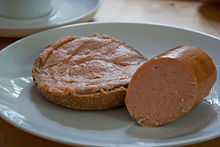Tea sausage
Teewurst is a spreadable smoked raw sausage produced exclusively in Germany .
Manufacturing

To make tea sausage, lean pork , pork belly and lean beef are finely chopped together by grinding and cutters . The mass is then typically seasoned with curing salt , pepper , sweet paprika , matzo and juniper rum. The filling takes place in artificial casings with a caliber of 45 mm / 40 cm. The ripening phase is 24 to 48 hours. Finally, the sausage is cold-smoked for 12 hours .
Sausages
In Germany, standard recipes are usually used in the production of sausage types. Examples are:
- Coarse tea sausage : sausage mass is only ground with a 3 mm disc, not chopped, Jamaica rum is another condiment , maturation phase from 12 to 24 hours, artificial casing caliber 43/50
- Coarse tea sausage Rügenwalder type : Sausage mass is only minced with a 3 mm disc, otherwise as Rügenwalder type
- Rügenwalder style sausage : Lean beef and pork with cold-smoked bacon , other spices are cardamom , ginger and honey
- Berliner Art sausage : Lean beef and pork, streaky pork, fresh bacon, other spices are cardamom, allspice and rum
- Göttinger Art sausage : Lean beef and pork, raw and freshly smoked bacon, flavors
- Pomeranian tea sausage : Lean beef and pork, fat pork belly, other spices are: white pepper, rose paprika , cardamom, allspice and rum. In the original, it was filled into narrow middle intestines with caliber 55/50. These sausages are also called Leipzig Christmas sausages .
Origin of the term
The origin of the term is unclear; tea was never included as an ingredient. One explanation relates to the company Rügenwalder Mühle . According to this, the origin of the tea sausage lies in the Rügenwalde in the rear of Pomerania . There, since 1874, the meat manufacturer Georg Wilhelm Heinrich Schmidthals (1837–1927) made them. His wife, the butcher's daughter Karoline Ulrike Rudolph (1841–1925), is said to have brought the recipe into the marriage in 1866. Later they are said to have looked for a name for the sausage, and since they ate sausage sandwiches and tea in the afternoon and found that this sausage went particularly well with tea, they named the sausage accordingly. Other sources say that the attribute “tea” was intended to remind people of “ lordly English customs ”.
Rügenwalder tea sausage
By 1945, a meat industry was able to establish itself in Rügenwalde , the best-known product of which was the tea sausage. In 1927 the term Rügenwalder Teewurst was legally protected as a geographical designation of origin. Sausage manufacturers expelled from Rügenwalde founded new businesses in West Germany and resumed the production of traditional tea sausages. In 1957 they founded the Association of Rügenwalder Fleischwarenfabrikanten in Bad Zwischenahn , an association of former Rügenwalder meat manufacturers that has since been the owner of the Rügenwalder Teewurst word mark . According to a ruling by the BGH , only companies that were formerly located in Rügenwalde are now allowed to use the brand name Rügenwalder Teewurst . Companies that cannot prove this parentage are only allowed to sell “tea sausage” or “Rügenwalder style tea sausage”.
The following three companies are currently allowed to use the Rügenwalder Teewurst brand name:
- Rügenwalder specialties Plüntsch GmbH & Co. KG
- Rügenwalder Mühle Carl Müller GmbH & Co. KG
- Wilhelm Brandenburg GmbH & Co. oHG .
Web links
Individual evidence
- ^ A b Hermann Koch, Martin Fuchs: The manufacture of fine meat and sausage products. 22nd expanded edition. Deutscher Fachverlag, Frankfurt am Main 2009, ISBN 978-3-86641-187-6 .
- ↑ Florian Langenscheidt (Ed.): German Standards: Brands of the Century . 15th, revised edition. Gabler et al. a., Wiesbaden a. a. 2006, ISBN 3-8349-0436-8 , pp. 448 ( google.com [accessed August 27, 2016]).
- ↑ Rügenwalder Mühle: Our craft tradition: tea sausage. May 29, 2013. Retrieved August 27, 2016 .
- ↑ Why Teewurst means Teewurst ... . wurstakademie.com. May 26, 2014. Retrieved July 2, 2017.
- ↑ Is there really tea in tea sausage? . inFranken.de. Retrieved July 2, 2017.
- ↑ Henning Burk, Erika Fehse, Marita Krauss, Susanne Spröer, Gudrun Wolter: Fremde Heimat - The fate of the expellees after 1945 . 1st edition 2011. Rowohlt Berlin Verlag GmbH, Berlin 2011, ISBN 978-3-8389-0164-0 , pp. 266 .
- ↑ See for example Volker Jänich : Intellectual property. A complementary phenomenon to property ownership? (= Jus privatum. Vol. 66). Mohr Siebeck, Tübingen 2002, ISBN 3-16-147647-6 , p. 164 (at the same time: Osnabrück, Universität, habilitation paper, 2000).
- ↑ Rügenwalder specialties Plüntsch: Yesterday & Today. Retrieved December 13, 2016 .
- ^ Rügenwalder Mühle: Our family history. Retrieved December 13, 2016 .
- ^ Wilhelm Brandenburg: Tradition. Retrieved December 13, 2016 .
